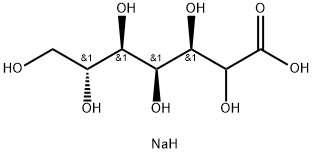
Sodium glucoheptonate
- русский язык имя
- английское имяSodium glucoheptonate
- CAS №31138-65-5
- CBNumberCB7430675
- ФормулаC7H15NaO8
- мольный вес250.18
- EINECS250-480-2
- номер MDLMFCD00013425
- файл Mol31138-65-5.mol
химическое свойство
| Температура плавления | 177 °C |
| Температура кипения | 117℃[at 101 325 Pa] |
| плотность | 1.45[at 20℃] |
| показатель преломления | 132.5 ° (C=1, H2O) |
| температура хранения | Inert atmosphere,Store in freezer, under -20°C |
| растворимость | DMSO: 50 mg/mL (175.94 mM);Ethanol: Insoluble |
| форма | Powder |
| цвет | White |
| Растворимость в воде | Freely soluble in water |
| LogP | -6.44 at 20℃ |
| Справочник по базе данных CAS | 31138-65-5(CAS DataBase Reference) |
| Вещества, добавляемые в пищу (ранее EAFUS) | SODIUM GLUCOHEPTONATE |
| FDA 21 CFR | 173.310; 176.150 |
| Система регистрации веществ EPA | D-gluco-Heptonic acid, monosodium salt, (2.xi.)- (31138-65-5) |
| Заявления о безопасности | 24/25 |
| WGK Германия | 3 |
| TSCA | Yes |
| кода HS | 2918.19.9000 |
рисовальное письмо(GHS)
-
рисовальное письмо(GHS)

-
сигнальный язык
предупреждение
-
оператор предупредительных мер
P270:При использовании продукции не курить, не пить, не принимать пищу.
P301+P312:ПРИ ПРОГЛАТЫВАНИИ: Обратиться за медицинской помощью при плохом самочувствии.
P403:Хранить в хорошо вентилируемом месте.
Sodium glucoheptonate химические свойства, назначение, производство
Использование
Sodium glucoheptonate is used for cleaning metal, mercerizing, paint stripping, and aluminum etching. It is also used to mercerize cotton, linen, hemp, and other plant-based fibers to increase strength and add luster to their overall appearance of threads and fabrics.Синтез
98 g (2 mol) of sodium cyanide and 300 g of water were charged into a flask fitted with a stirrer, thermometer and a connection to a water jet aspirator. The contents of the flask were cooled to 2 ℃. using an ice bath. 396 g (2 mol) of dextrose hydrate were charged into the flask over about 30 minutes. When the sugar had all been charged, the temperature rose to 8 ℃., when the vacuum jet was turned on to provide a vacuum of about 40 mm of Hg. Within about 30 minutes, the temperature rose to 27 ℃., when the ammonia began to boil off vigorously. Within approximately 1 hour, the alpha sodium glucoheptonate dihydrate began to crystallize. The removal of the ammonia was continued at 27 ℃ and a vacuum of 33-40 mm of Hg for 6 hours. The crystals were filtered, water washed, and air dried. The first crop yield of alpha sodium glucoheptonate was -328 grams or 57.7% of the theoretical.Sodium glucoheptonate поставщик
| поставщик | телефон | страна | номенклатура продукции | благоприятные условия |
|---|---|---|---|---|
| +8615531157085 | China | 8804 | 58 | |
| +86 13288715578 +8613288715578 |
China | 12825 | 58 | |
| +8617531153977 | China | 5855 | 58 | |
| +86-15532196582 +86-15373005021 |
China | 3007 | 58 | |
| +8613343047651 | China | 3692 | 58 | |
| +8613288715578 | China | 1174 | 58 | |
| +86-0371-55170693 +86-19937530512 |
China | 21632 | 55 | |
| 008657128800458; +8615858145714 |
China | 7738 | 55 | |
| +86-0551-65418679 +8618949832763 |
China | 2986 | 55 | |
| +86-0371-86658258 +8613203830695 |
China | 29871 | 58 |